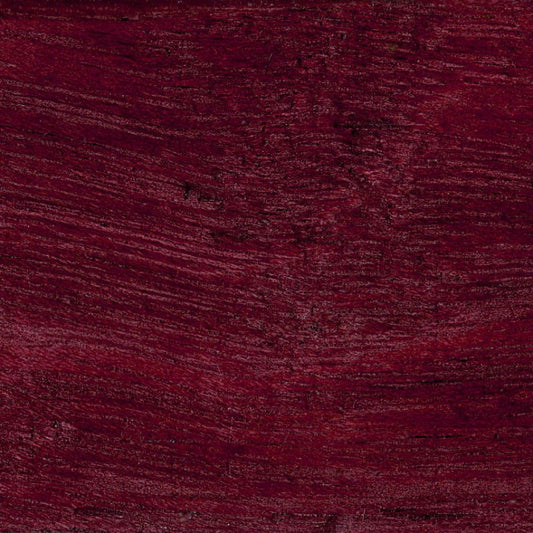Purple Heart Lumber
-
Purple Heart Hardwood Lumber Top Grade FAS - 25 bdft pack
Regular price From $325.00 USDRegular priceUnit price / per
Collection: Purple Heart Lumber
Common Name: purpleheart, Violeta, amaranth, violetwod, purperhard, roxinho
Scientific Name: Peltogyne spp.
Color Range: dull grayish to purplish brown heartwood that changes to deep purple as the wood is exposed to elements; further aging and exposure to UV rays result in a dark brown hue with hints of purple; white to yellow sapwood
Availability: widely available
Janka Hardness Scale: 1860 lbf
Average Weight per BF: 5.02 lbs/ Bd. Ft.
What Is Purple Heart Wood?
Purple heart trees stand from 100 to 170 ft tall (30-50 m) with a trunk diameter of 3 to 5 ft (1-1.5 m). The genus Peltogyne consists of more than 20 species; not all age to that stunning purple hue. In general, purple heart wood starts as a grayish/brownish color that develops into a deep eggplant purple after several weeks of drying. The wood grain is usually straight but may display other patterns or become wavy.
Since the purple heart has many species under its genus, its sustainability can be confusing. Some commonly harvested purple heart species are not listed on the IUCN Red List, a list of species on the brink of extinction. However, two purple heart species, P. chrysopis and P. gracilipes have been listed as endangered.
Where Does Purple Heart Come From?
Purple heart is an imported wood. The available purple heart lumber in the United States is mostly sourced from different places in Central and South America. The Amazon Basin houses the majority of purple heart trees.
It is found in the rainforests of the following countries: Brazil, Guyana, Suriname, Trinidad, Panama, Costa Rica, Venezuela, Bolivia, and Columbia, among others. It can also be found in Guerrero, a Mexican state.
Purple heart trees are not commercially cultivated. This can greatly threaten their extinction because of the overharvesting of naturally grown trees. Countries like Panama and Costa Rica have set laws to regulate purple heart harvesting and prevent overexploitation.
Is Purple Heart Hardwood or Softwood?
Purple heart is hardwood, but this should not be misconstrued as having something to do with its durability and hardness.
Hardwood and softwood are categorized by their ability to shed off leaves. Hardwood, usually broadleaf and deciduous trees, loses their leaves during autumn and winter but regains them by spring.
Meanwhile, softwoods are mostly conifer trees that are in the gymnosperm group. Like pine and fir, this group retains its leaves throughout the year regardless of the season.
How Dense/Hard is Purple Heart?
Purple heart is known for its durability and hardness with a Janka score of 1860 lbf. It means that purple heart almost has the same hardness as pecan (1820 lbf) and hickory (1880 lbf). This hardness does not come with a free pass, as it can have its own pitfalls.
The hardness and natural oils contained within the tree may dull and weaken tools and dull saw edges. The gummy resin inside it can clog up the tools, making workability more difficult. Using dull tools or high-speed cutters can also pose issues.
What to Look for When Buying Purple Heart Lumber
Purple heart lumber has an exotic flair that is difficult to miss. The deep purple hue always stands out from other wood varieties. But not all purple heart lumber is equal, and you need to know which ones to purchase.
Always check for grain orientation. Choose wood with straight grain compared to wavy or with different patterns. A wood with a straight grain orientation is easier to plane without causing tearouts.
Ask for the drying method and how long the lumber has been dried. Purple heart exposes their deep purple color depending on their exposure to elements. And don’t forget to inquire about the wood’s lumber grade. The lumber grade determines its quality and perfect appearance.
FAQs
Can purple heart furniture go outside?
Purple heart resists stress and decay and thus can be used for outdoor applications such as decking and furniture. It is also used in marine applications like boat building due to its strength and durability to resist weather elements.
How to care for purple heart furniture?
While it can be used outdoors, purple heart wood will change its color from deep purple to dark brown, laced with purple streaks after constant UV exposure. To slow down this change, apply a UV-inhibiting finish on the surface of the wood for protection.
Is purple heart sustainable?
Currently, only a couple of purple heart species are listed as endangered. However, that does not mean the rest of the species are safe from overharvesting.
Where to Buy Purple Heart Lumber
Purple heart is astonishingly attractive and economically priced. Its strength, tripled with its visual and affordability, makes it a top lumber choice for many. But, since purple heart trees are imported wood and are not commercially cultivated, there is a risk in their sustainability.
To save purple heart trees from overharvesting, always buy lumber and wood products from reputable and reliable sellers like Alderfer Company Inc. We guarantee that all our wood supplies are ethically and sustainably sourced to minimize environmental impact.
Our inventory of purple heart lumber is constantly changing. It is best for you to contact us for inquiries about our current supply and the top-grade lumber available.

